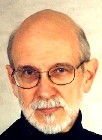|
Jerome A. Stone
Jerome A. Stone (born 1935) is an American author, philosopher, Congregationalist minister,[1] and theologian. He is best known for helping to develop the religious movement of religious naturalism. Stone is on the Adjunct Faculty of Meadville Lombard Theological School; is Emeritus Professor of Philosophy at William Rainey Harper College; is in Preliminary Fellowship with the Unitarian Universalist Association; and is a member of the Highlands Institute of American Religious and Philosophical Thought[2] and the Institute on Religion in an Age of Science (IRAS). BiographyStone grew up in Connecticut and Rhode Island, the son of a Protestant pastor. Though his family was of modest means he had access to a broad range of books. His father taught him respect for other religions early on. He was educated in the aesthetic and moral dimensions of church life. Instead of oppressive moralism, he was given a vision of moral integrity, service and a sense of the numinous. At the age of sixteen he left home, an early entrant to the University of Chicago. After a year of graduate studies, he transferred to Andover Newton Theological School outside of Boston, MA. His M.Div. thesis was done there on Paul Tillich’s Concept of God as the Ground of Being. He then continued his graduate training at the University of Chicago Divinity School, completing his doctorate there in 1973. His doctorate thesis was done on The Secular Experiences OF Transcendence: The Contributions of Bernard Meland, H. Richard Niebuhr and Paul Tillich. During this time he served as pastor at three Congregational and United Church of Christ churches. He helped organize the Danville Council on Human Relations which is said to have become the seed bed for the first Head Start program to receive funding. He went on to teach religion, philosophy, ethics and racism in America at Kendall College, William Rainey Harper College and later at the Meadville Theological School. Over these years he developed a strong environmentalism. In 2002, Stone wrote:
Stone has moved from liberal Protestantism through a flirtation with neo-orthodoxy to a more serious wrestling with Paul Tillich and finally to a Religious Naturalism shaped by Henry Nelson Wieman, Bernard Meland and John Dewey. Religious naturalismStone's latest work, Religious Naturalism Today: The Rebirth of a Forgotten Alternative, looks at the history and revival of Religious Naturalism, a 1940s option in religious thinking. It seeks to explore, develop and encourage spiritual ways of responding to the world on a completely naturalistic basis without a supreme supernatural being. Stone traces its history and analyzes some of the issues dividing Religious Naturalists. He includes analysis of nearly fifty distinguished philosophers, theologians, scientists, and figures in art and literature, both living and dead. They range from Ursula Goodenough, Gordon D. Kaufman, William Dean, Thomas Berry and Gary Snyder to Jan Christiaan Smuts, William Bernhardt, Gregory Bateson and Sharon Welch. His history includes its birth from George Santayana to modern contributors such as Henry Nelson Wieman, Loyal Rue and Chet Raymo. He briefly explores Religious Naturalism in literature and art. Contested issues are discussed including whether Nature's power or goodness is the focus of attention and also on the appropriateness of using the term God. Mary Doak, author of Reclaiming Narrative for Public Theology says of it: [1]
The individual perspectives on Religious Naturalism of Loyal Rue, Donald A. Crosby, Ursula Goodenough and Stone are discussed by Michael Hogue in his 2010 book The Promise of Religious Naturalism.[4] WorksMajor publications
Major articles
References
External links |
||||||||||||||||
